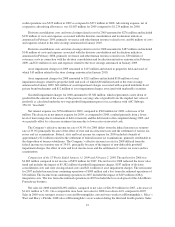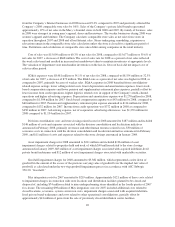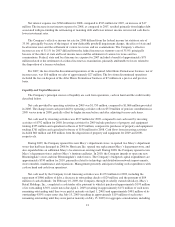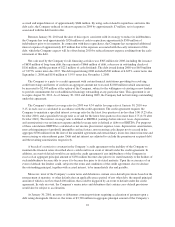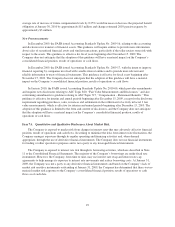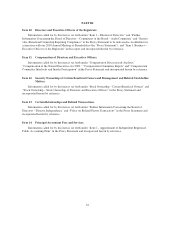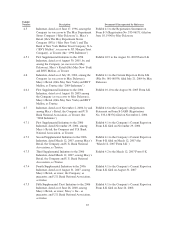Macy's 2009 Annual Report Download - page 35
Download and view the complete annual report
Please find page 35 of the 2009 Macy's annual report below. You can navigate through the pages in the report by either clicking on the pages listed below, or by using the keyword search tool below to find specific information within the annual report.average rate of increase of future compensation levels by 0.25% would increase or decrease the projected benefit
obligation at January 30, 2010 by approximately $15 million and change estimated 2010 pension expense by
approximately $3 million.
New Pronouncements
In December 2009, the FASB issued Accounting Standards Update No. 2009-16, relating to the accounting
and disclosures for transfers of financial assets. This guidance will require entities to provide more information
about sales of securitized financial assets and similar transactions, particularly if the seller retains some risk with
respect to the assets. This guidance is effective for fiscal years beginning after November 15, 2009. The
Company does not anticipate that the adoption of this guidance will have a material impact on the Company’s
consolidated financial position, results of operations or cash flows.
In December 2009, the FASB issued Accounting Standards Update No. 2009-17, with the intent to improve
financial reporting by companies involved with variable interest entities and to provide more relevant and
reliable information to users of financial statements. This guidance is effective for fiscal years beginning after
November 15, 2009. The Company does not anticipate that the adoption of this guidance will have a material
impact on the Company’s consolidated financial position, results of operations or cash flows.
In January 2010, the FASB issued Accounting Standards Update No. 2010-06, which provides amendments
and requires new disclosures relating to ASC Topic 820, “Fair Value Measurements and Disclosures,” and also
conforming amendments to guidance relating to ASC Topic 715, “Compensation – Retirement Benefits.” This
guidance is effective for interim and annual periods beginning after December 15, 2009, except for the disclosure
requirement regarding purchases, sales, issuances and settlements in the rollforward of activity in Level 3 fair
value measurements, which is effective for interim and annual periods beginning after December 15, 2010. The
adoption of this guidance is limited to the form and content of disclosures, and the Company does not anticipate
that the adoption will have a material impact on the Company’s consolidated financial position, results of
operations or cash flows.
Item 7A. Quantitative and Qualitative Disclosures About Market Risk.
The Company is exposed to market risk from changes in interest rates that may adversely affect its financial
position, results of operations and cash flows. In seeking to minimize the risks from interest rate fluctuations, the
Company manages exposures through its regular operating and financing activities and, when deemed
appropriate, through the use of derivative financial instruments. The Company does not use financial instruments
for trading or other speculative purposes and is not a party to any leveraged financial instruments.
The Company is exposed to interest rate risk through its borrowing activities, which are described in Note
11 to the Consolidated Financial Statements. The majority of the Company’s borrowings are under fixed rate
instruments. However, the Company, from time to time, may use interest rate swap and interest rate cap
agreements to help manage its exposure to interest rate movements and reduce borrowing costs. At January 31,
2009, the Company was not a party to any derivative financial instruments and based on the Company’s lack of
market risk sensitive instruments outstanding at January 31, 2009, the Company has determined that there was no
material market risk exposure to the Company’s consolidated financial position, results of operations or cash
flows as of such date.
29


